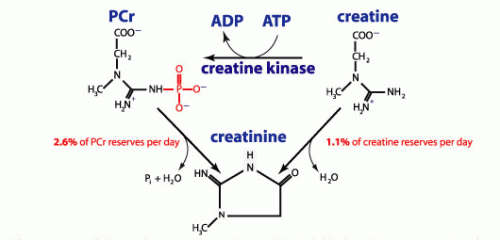Creatine and athletic performance
There is scientific evidence that short term creatine use can increase maximum power and performance in high-intensity anaerobic repetitive work (mere seconds to 2minutes) by 5 to 15%. This concerns multiple sets of low Reps at Max weightlifting. Single effort work shows an increase of 1 to 5%. This refers to single lifting of 1-2 Reps at Max weights.
It must be noted creatine has no significant effect on aerobic endurance, though it will increase power during short sessions of high-intensity aerobic exercise.
Since body mass gains of about 1 kg can occur in a week’s time, many studies suggest that the gain is simply due to greater water retention inside the muscle cells.
Other studies, however, have shown that creatine increases the activity of satellite cells, which make muscle hypertrophy possible. Creatine supplementation appears to increase the number of myonuclei that satellite cells will ‘donate’ to damaged muscle fibers, which increases the potential for growth of those fibers.
Another team of researchers discovered that after weight training fat mass did not change significantly with creatine where it decreased after the placebo. The study also showed that 1-Rep at Max bench press and total body mass increased after creatine, but not after placebo.
Creatine use is not considered doping and is not banned by the majority of sport-governing bodies.
Endocrine effects
Two major endocrine effects have been revealed:
– An Increase in dihydrotestosterone levels, while testosterone levels stay unchanged. This could explain the fact that creatine users tend to report a slight onset of acne after starting creatine supplementation. It could also be a factor when it comes to the increased athletic performance that has been correlated with creatine supplemenation, although dihydrotestosterone has only minor anabolic effects compared to testosterone.
– An Increase in muscle insulin-like growth factor-I (IGF-I), an hormone involved in osseous growth.
Creatine ingestion
Creatine is often taken by athletes to help as a supplement for those wishing to gain muscle mass (bodybuilding). There are a number of forms but the most common are creatine monohydrate (creatine complexed with a molecule of water) and creatine ethyl ester (CEE).
Ingestion may be as a powder mixed into a drink, or as a capsule or caplet. Once ingested, creatine is highly bioavailable (fraction reaching the systemic circuation similar to injected drugs) , whether it is ingested as capsule or powder.
Conventional wisdom recommends the consumption of creatine with high glycemic index carbohydrates (e.g. white bread, white rice, pasta).
The plasma creatine level hits a peak of 10 times the normal concentration 1-2 hours after a single 5g oral ingestion.
Creatine has a fairly short elimination half-life, averaging just less than 3 hours, so to maintain an elevated blood plasma level it would be necessary to take small oral doses every 3–6 hours throughout the day.
There are two scientifically proven ways to supplement with creatine. The first is through a loading phase, in which 20 grams a day is taken for 5–7 days, followed by a maintenance phase of 3-5 grams a day for periods of 2–3 months at a time.
The second consists of taking 3-10 grams of creatine per day for a period of 2–3 months with no loading phase.
It is generally recommended to take at least 1–2 weeks off from creatine supplementation in order to maintain a proper response mechanism in the body.
As with most supplements, each person has their own genetic “preset” amount of creatine they can hold. The rest is eliminated out of the body as waste.
Other forms of Creatine
Beside Monohydrate creatine other forms of creatine are available.
Creatine ethyl ester:
Creatine ethyl ester CEE is a form of commercially available creatine touted to have higher absorption rates and a longer serum half-life than regular creatine monohydrate by several supplement companies. However, no peer-reviewed studies have emerged on creatine ethyl ester which conclusively prove these claims.
A study presented at the 4th International Society of Sports Nutrition (ISSN) annual meeting demonstrated that creatine ethyl ester is inferior to creatine monohydrate as a source of creatine.
Creatine hydrochloride :
Creatine hydrochloride CrHCl is a hydrochloride salt patented in 2009 and marketed as an athletic and bodybuilding supplement. Due to its higher solubility, the recommended dosage for CrHCl is much lower than that for creatine monohydrate.
Safety
Current studies indicate that short-term creatine supplementation in healthy individuals is safe, although those with renal disease should avoid it due to possible risks of renal dysfunction, and before using it healthy users should bear these possible risks in mind.
There have been reports of muscle cramping with the use of creatine, though no study could confirm this fact.
In 2004 the European Food Safety Authority (EFSA) published a record that stated that oral long-term intake of 3 g pure creatine per day is risk-free.The reports of damage to the kidneys or liver by creatine supplementation have been scientifically refuted.
Creatine and mental performance
Creatine administration was shown to significantly improve performance in cognitive and memory tests in vegetarian individuals.
by Vic Veeraj Goyaram (africanmuscle)



Post your comment